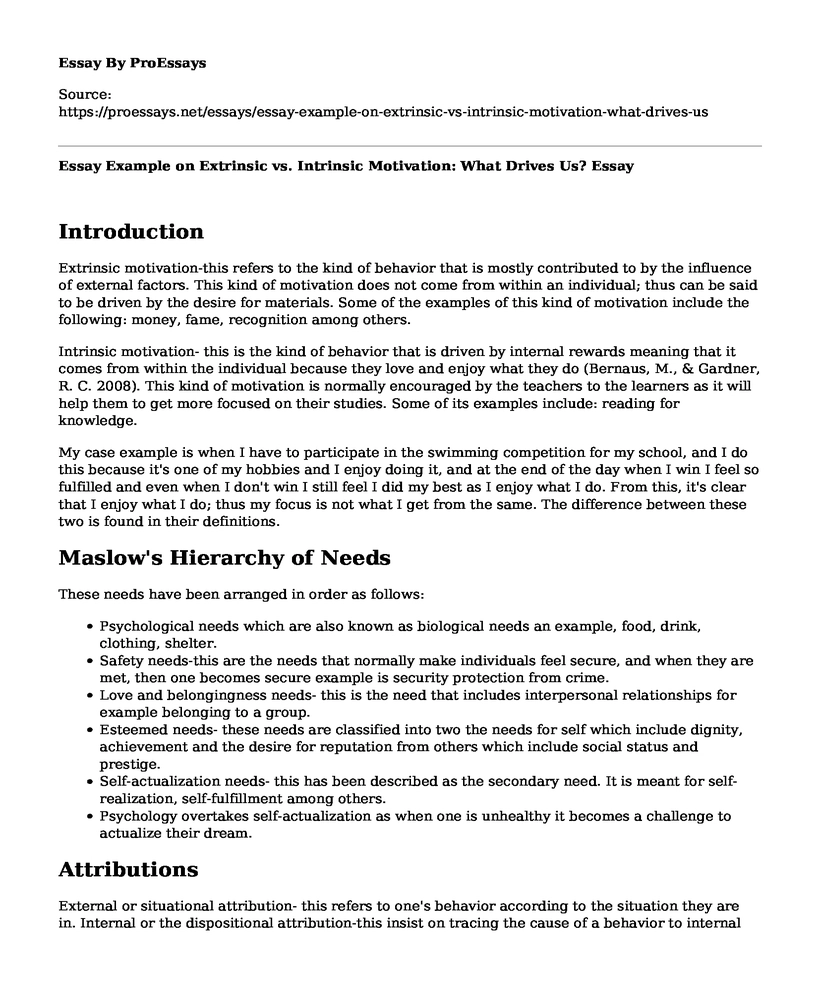Introduction
Extrinsic motivation-this refers to the kind of behavior that is mostly contributed to by the influence of external factors. This kind of motivation does not come from within an individual; thus can be said to be driven by the desire for materials. Some of the examples of this kind of motivation include the following: money, fame, recognition among others.
Intrinsic motivation- this is the kind of behavior that is driven by internal rewards meaning that it comes from within the individual because they love and enjoy what they do (Bernaus, M., & Gardner, R. C. 2008). This kind of motivation is normally encouraged by the teachers to the learners as it will help them to get more focused on their studies. Some of its examples include: reading for knowledge.
My case example is when I have to participate in the swimming competition for my school, and I do this because it's one of my hobbies and I enjoy doing it, and at the end of the day when I win I feel so fulfilled and even when I don't win I still feel I did my best as I enjoy what I do. From this, it's clear that I enjoy what I do; thus my focus is not what I get from the same. The difference between these two is found in their definitions.
Maslow's Hierarchy of Needs
These needs have been arranged in order as follows:
- Psychological needs which are also known as biological needs an example, food, drink, clothing, shelter.
- Safety needs-this are the needs that normally make individuals feel secure, and when they are met, then one becomes secure example is security protection from crime.
- Love and belongingness needs- this is the need that includes interpersonal relationships for example belonging to a group.
- Esteemed needs- these needs are classified into two the needs for self which include dignity, achievement and the desire for reputation from others which include social status and prestige.
- Self-actualization needs- this has been described as the secondary need. It is meant for self-realization, self-fulfillment among others.
- Psychology overtakes self-actualization as when one is unhealthy it becomes a challenge to actualize their dream.
Attributions
External or situational attribution- this refers to one's behavior according to the situation they are in. Internal or the dispositional attribution-this insist on tracing the cause of a behavior to internal characteristics example is motivation. Attribution has been classified into different sections which include the following: locus of control this can be grouped into external and internal, stability where the attribution causes change over a period of time or not an example is ability which is stable within an individual as it's an internal cause and effort which is said to be unstable as it varies from one individual to another, controllability which is the contrast or the conflicting causes that one can take charge of an example is the skill and efficiency which can be controlled and mood as well as luck which cannot be controlled by an individual.
From the above explanations, we are able to derive the two attributions
1. Controllable attributions which can be controlled such as effort and task difficulty.
2. Uncontrollable attributions which can be not be changed as they are internal factors example effort and IQ
7 Motivational Strategies
Task -this is the activities that one has to undergo in different situations.
Autonomy -this includes the amount of choice that one has and this normally influences the level of motivation that an individual has.
Recognition -this can be classified as an extrinsic form of motivation thus being given as a reward.
Groupings - this is whereby people are divided into different categories in order to perform certain activities.
Evaluation -this is the assessment that is done from time to time to different individuals in order to keep the work on the check.
Time-the amount of time that is allocated to the evaluation, as well as tasks, can affect the motivation that an individual has.
Sustenance- all that has been done.
The teacher may incorporate this in class through discussions groups, evaluation tests and offering assignments as tasks.
References
Bernaus, M., & Gardner, R. C. (2008). Teacher motivation strategies, student perceptions, student motivation, and English achievement. The Modern Language Journal, 92(3), 387-401
Cite this page
Essay Example on Extrinsic vs. Intrinsic Motivation: What Drives Us?. (2023, Jan 03). Retrieved from https://proessays.net/essays/essay-example-on-extrinsic-vs-intrinsic-motivation-what-drives-us
If you are the original author of this essay and no longer wish to have it published on the ProEssays website, please click below to request its removal:
- Research Paper on Childhood Depression
- Essay Sample on Equip Students for a Bright Future: Benefits of Career and Technical Education
- Literary Analysis Essay on It Ends With Us
- Essay Sample on English Stress & Intonation: Enhancing Word Understanding
- Paper Example on Overcoming MDD: A Patient's Journey & Evidence-Based Strategies
- Chemical Safety in the Workplace: Protecting Workers and Businesses - Essay Sample
- Paper Example on Managing Postpartum Depression: Coping Style & Prevalence Rates







